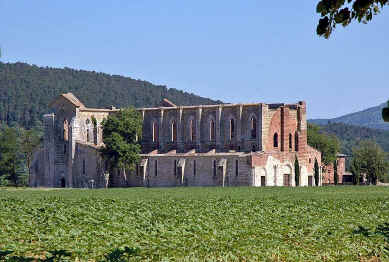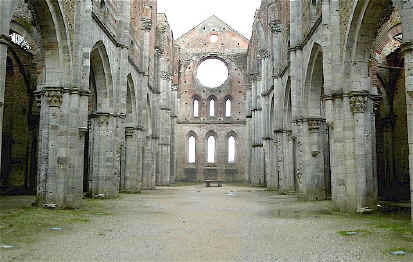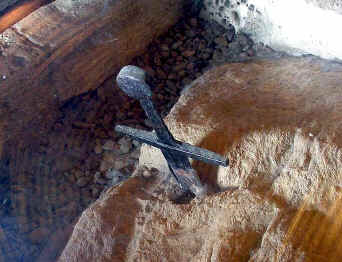Getting to the Abbey of San GalganoThe Abbey of San Galgano is in the Val di Merse, about 40 km southwest of Sienna towards Grosseto in the isolated valley of the river Merse (Val di Merse). To reach it, take State Highways 73 and 441, towards Massa Marittima (San Galgano is about half way between Siena and Massa Marittima). It's a very pretty drive, and the grass makes the abbey a perfect spot for picnicking. The round temple is, like most Italian churches, open in the morning. The abbey is open throughout the day and early evening. Abbazia di San GalganoAbbey of San Galgano
The Abbey (Abbazia) of San Galgano was built along the classic gothic lines of all Cistercian constructions, as a daughter house of Saint Bernard's at Clairvaux in France. It was Tuscany's first pure Gothic church, and later the model for Sienna Cathedral. It has the typical Cistercian plan based on a latin cross with three aisles, rich in carved capitals and rose windows, with a cloister, halls, and, atypically, a bell tower. The richness of S. Galgano and its good relationship with Sienna attracted the incursions of the Florentine armies which, together with other political events, resulted in the rapid decline of the abbey beginning in the first half of 15 C. By 1550, only five monks were in the abbey and they sold off any remaining treasures plus the lead roof, sealing the fate of the building. At the beginning of the 17 C, only one old and poor monk still lived between its already ruined walls. On 6 January 1786, the 36 m bell tower collapsed, sweeping away a great part of the roof of the church and in 1789 the great Abbey was definitively abandoned and become an enormous quarry of stones and columns for the builders of the area. Fortunately, from the beginning of the 20 C, much restoration and maintenance have been undertaken, so that today the ruins of Saint Galgano are one of the most popular attractions of Tuscany. Nave of the Abbey of San Galgano Hermitage of MontesiepiHermitage of Montesiepi The Hermitage (Eremo) of Montesiepi, built between 1182 and 1185 in Romanesque style as the mausoleum of Saint Galgano (Galgano Guidotti 1148-1181), is the original nucleus of the Cistercian monastic complex here. The Rotunda of Saint Galgano encloses the tomb of the saint and the famous rock with the sword embedded in it. Although at a first sight, it can seem to be an emulation of the ancient Etruscan tombs of Populonia, Vetulonia and Volterra, the architect was in fact inspired by Castel Sant'Angelo and the Pantheon in Rome. In the following centuries, the Rotunda suffered the ravages of time and passing armies, but it was well restored in 1924. The dome is constructed using 24 concentric, alternated rows of white stone and bricks, with spectacular effect when viewed from the interior. Montesiepi chapel ceiling With the growth of the interest in the cult of Saint Galgano, many rich nobles contributed to the embellishment of the Rotunda, and the construction of a Chapel on the north side was begun in 1340. The interior was frescoed by Ambrogio Lorenzetti and some of his work has been restored and is still visible. The hermitage eventually became too small for the increasing numbers of monks and the pilgrims, and as a consequence a decision was made in 1218 to begin the construction of a new imposing Abbey in the plain below. The work was encouraged by the Bishop of Volterra.
San Galgano and the sword in the stoneAbout a ten minute walk up the hill from the Abbey, inside the Hermitage of Montesiepi, one of the most fascinating and mysterious relics of the entire region of Tuscany is kept: the sword in the stone of Saint Galgano. A jagged piece of rock protrudes from the centre of the tile floor of the chapel and in it lies the famous sword. The cross-shaped sword has been proven to date back to 1170. In the chapel there are even some frescos from the 1300's which depict the chapel itself. The sight, to say the least, is evocative and immediately brings to mind the well-known legend of King Arthur and his sword in the stone, and it seems there might be a connection. Galgano was a young knight born a few kilometers from the city of
Sienna, in
Tuscany, in the year 1148. The legend says that one night Galgano had a vision of
the Archangel Michael. The archangel was guiding him down a narrow and difficult
path to Montesiepi where he was eventually greeted by the twelve apostles in
front of a circular-shaped temple. More about San Galgano and the Val di Merse |




